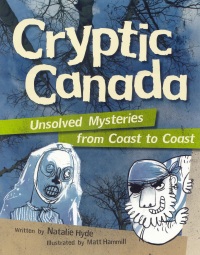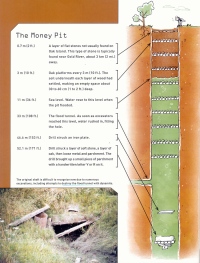| ________________
CM . . .
. Volume XIX Number 16. . . .December 21, 2012
excerpt:
Canadian students who dream of uncovering ancient mysteries in exotic lands may be surprised to learn that we have many unsolved riddles in our own backyard. In this short and easy read, author Natalie Hyde and illustrator Matt Hammill team up with publisher Owlkids to explore seven of Canada's most engaging unsolved mysteries. A prolific non-fiction writer, Hyde has penned over twenty titles on a wide range of topics from sports to germ theory.
The content is interesting and engaging, yet easy to read. This, combined with short chapters and the quick flow of the text, makes this title a good choice for reluctant or struggling readers. The book does contain some difficult vocabulary and scientific jargon from time to time (i.e.: solstice, carbon dating, etc.); however, these possibly unfamiliar terms are explained quite well in the body of the text. The book contains seven chapters, each examining a different Canadian mystery. The author has made a good attempt at featuring riddles from most regions in Canada – from ice mummies in the far North to the Viking longhouses of the East coast. It is also worth noting that the mysteries reach across time as well as space, with some of them being ancient puzzles and others taking place in modern times. Each chapter is neatly divided into four parts. The first section, titled 'History Mystery', gives a short historical overview of the mystery. The second section, 'Puzzle Pieces', outlines which clues have been uncovered to date. The third section, 'What Now?', brings the reader to the present day and discusses current research that is attempting to answer any remaining questions. Each chapter ends with an interview with an expert in the field. Discussions with a historian, a professor and a journalist (among others) are included. This interview section is a nice feature of the book, and it may inspire inquisitive kids to consider a career in a research-based profession. One major drawback of this book is that it contains at least one factual error. Chapter four, titled 'Little Chicago', explores a secret network of tunnels under the city of Moose Jaw that were believed to have been used by gangsters and bootleggers in the early 1900s. At the start of the chapter, the author correctly states that the city of Moose Jaw is located in the province of Saskatchewan. However, only a page later, Moose Jaw is erroneously placed in Manitoba. The text goes on to reference the Prohibition Act of Manitoba which was ratified in 1906. It seems very odd that the author would invest so much time and effort into researching and writing a book only to make such a glaring error. Less observant readers may not notice this inconsistency, but, as a critical reviewer, I question what other "facts" are incorrect. Cryptic Canada scores full marks for its beautiful layout and presentation. However, due to at least one factual error, the text should be approached with caution. This title could be considered as a nonessential addition to a classroom library. Recommended with reservations. Michelle Brown is a librarian in the Faculty of Education at the University of Ottawa in Ottawa, ON.
To comment
on this title or this review, send mail to cm@umanitoba.ca.
Copyright © the Manitoba Library Association. Reproduction for personal
use is permitted only if this copyright notice is maintained. Any
other reproduction is prohibited without permission.
NEXT REVIEW |
TABLE OF CONTENTS FOR THIS ISSUE
- December 21, 2012
AUTHORS |
TITLES |
MEDIA REVIEWS |
PROFILES |
BACK ISSUES |
SEARCH |
CMARCHIVE |
HOME |

 The colourful and unique layout is sure to appeal to young readers. Full colour illustrations and photographs are found on every page and are carefully arranged for maximum visual impact. The page that marks the start of each new chapter is shaped like a file folder, giving readers the feeling that they are holding an unsolved case file in their hands.
The colourful and unique layout is sure to appeal to young readers. Full colour illustrations and photographs are found on every page and are carefully arranged for maximum visual impact. The page that marks the start of each new chapter is shaped like a file folder, giving readers the feeling that they are holding an unsolved case file in their hands.